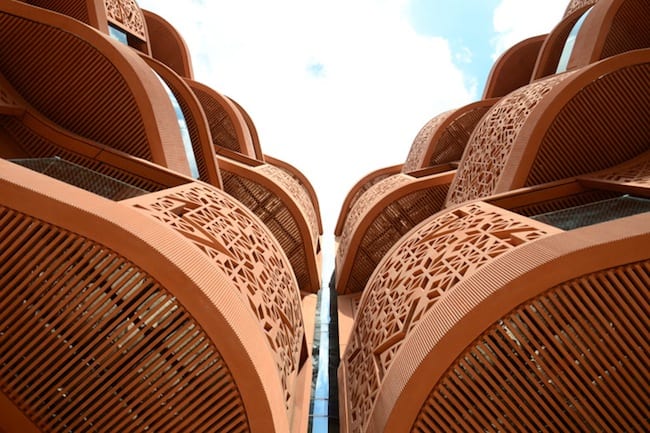Firm Foster + Associates worked with the Abu Dhabi Future Energy Company to create Masdar, a multi-billion dollar project to build the world’s first carbon-neutral, zero-waste city in which ceramic cladding plays a strong role both aesthetically and functionally.
The city, a hub for clean energy companies, is powered entirely by renewable energy sources such as solar power. This is accompanied by careful design of the 6-square kilometer layout. Streets, plazas and buildings work to eliminate the temperatures by facing away from the sun, a perimeter wall keeps out hot desert winds, cool breezes are funneled through the streets and transportation is done primarily through mass transit.
The project began in 2008 and in 2010, Foster announced the opening of the Masdar Institute, a building entirely powered by solar energy. The institute, according to the architects, is devoted to researching sustainable energy sources to be used in future Masdar projects.
Arch Daily reports that criticism has been leveled at the development. Buildings comprise about 10 percent of the city, leaving a lot of empty space. But we at CFile think this criticism is short-sighted given the relative newness of this planned urban center. A pitfall of designing such a space would be to put too much focus on eliminating energy consumption while ignoring aesthetics. It could result in a depressing series of lookalike buildings- clean, efficient, important, but ultimately soulless. That’s not what we’re seeing here.
The ceramic facades and metal screens of the buildings have traditional patterns and designs from traditional tile design and wooden screens that maintain a unified look due to the single terracotta color. It is inspired by the inland tradition to build of stone guss (mud mixture made into blocks) and the use of red Iranian clay for plastering.
Cities have unique identities, and usually these are achieved after centuries of development, but there could be benefits to creating whole urban areas with specific intent. With Masdar, we’re treated to beautiful structures that share a goal of eliminating heat, waste and keeping their inhabitants comfortable. There’s something to be said for that. We cover many architects who build or refurbish buildings to achieve current sustainability trends, incorporating modern design into existing urban areas. It’s interesting that Masdar’s starting point uses the best energy practices we have right now and is pushing that idea forward with concepts such as the Institute. We can’t wait to see how this unfolds and the city is populated and its social milieu evolves.
Bill Rodgers is a Contributing Editor at CFile.
Above image: Masdar City in Abu Dhab
Any thoughts about this post? Share yours in the comment box below.









Masdar City in Abu Dhabi.

art ceramic
beautiful building!!
I think it is beautiful. I would live there.